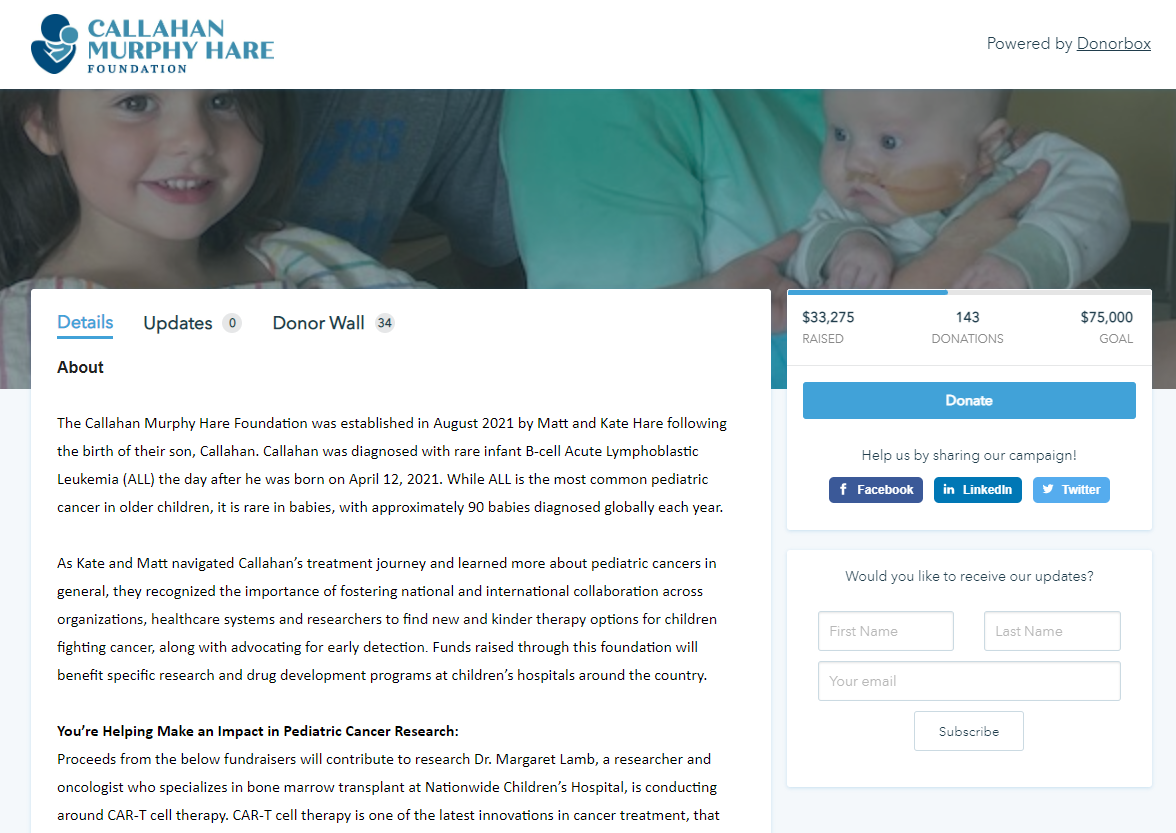Research is a vital part of the medical field. Many nonprofits have made it their mission to research and cure various diseases. The ALS Association found immense fundraising success with their Ice Bucket Challenge and significantly increased research spending for the illness. Today, ALS is closer than ever to finding a cure.
However, the fact remains – that medical research is costly. Organizations struggle to find qualified staff, trial volunteer reimbursement, specialized tools and machines, medical conferences, and more.
The following tips will help medical research institutes find new funding sources and have a better chance of meeting their revenue goals.
- Have an Online Donation Page
- Segment Donors for Personalized Approach
- Encourage Recurring Donations
- Hold Crowdfunding Campaigns for Specific Research Needs
- Tell Compelling & Positive Stories of Impact
- Keep Communicating
- Raise Funds Through Community Events
- Turn Your Donors into Advocates
- Build Corporate Partnerships
- Get the Media Involved
- Don’t Forget Offline Appeals
- Take Feedback and Improve
1. Have an Online Donation Page
Many donors are more comfortable giving online than by mail or in person. Donors feel more confident in the safety and convenience of donating online from anywhere. With the addition of mobile and text giving, donating online is often easier than any other payment type.

Medical research organizations with an online donation page can collect donations by credit card, payment applications like PayPal, Venmo, Apple Pay, or Google Pay, or directly from a donor’s bank account via ACH bank transfers, UK Direct Debit, Canadian PADs, etc.
Donorbox is currently one of the most affordable options out there, with no sign-up or monthly fee. You can easily customize your donation form and embed it into your existing website (no coding knowledge required) or you can use a Donorbox-hosted free donation page to accept donations. In the example below, TANGO2 Research Foundation has embedded the Donorbox donation form into their donation page to accept donations. The form encourages recurring monthly donations, suggests donation amounts, and fetches information important to the organization.

Pro tip: Ensure your donation page is mobile optimized. As per the latest statistics, the average conversion rate for donation pages is 8% on mobile devices, and completed transactions have increased by 50%.
2. Segment Donors for Personalized Approach
Organizations that collect detailed information on each donor and donor type have an easier time creating the communication pieces. When your nonprofit receives a donation, there are several details you should collect:
- Date of the first donation
- Contact details
- What brought them to the organization
- Internal connections
- Programs that interest them
- Ability to give
This information will be used to segment donors and create moves management plans. Moves management is a way to build and strengthen relationships with donors. Whether the individual qualifies as a major donor, corporation, or gives smaller annual gifts, your organization can separate them into groups and connect with them in different ways.
Donorbox lets you segment your supporters through different filters on the donor database. Nonprofits can also add communication notes to each donor profile for improved marketing and communication.

Pro tip: Segment your donors with respect to their giving abilities. That will help you determine the donation amount ranges and the most frequent donation amounts you receive. Add these amounts as suggestions to your donation form, provide impact details of each amount, and inspire donors to give more. The more personalized your approach, the better your chances of securing a donation.
3. Encourage Recurring Donations
One option your institute can give donors is the chance to give weekly, monthly, quarterly, or annually. Recurring donations can be an excellent way to ensure long-time gifts. Medical research institutes can depend on these gifts and add them to their annual budget.
However, it takes efforts to turn a one-time donor into a recurring donor. Nonprofits should create unique fundraising appeals for recurring donors and ensure their long-term involvement with the institute.
Rare Cancer Research Foundation has been using a recurring donation form for accepting their donations. They have the monthly option enabled and also suggest a few donation amounts as per their donor segmentation research.

Pro tip: People who opt to become recurring donors are naturally more dedicated to your mission. Give these donors a more manageable donation experience. Donors who can manage their recurring donation plans, cancel, pause, and resume them at any time, track donation receipts of all their donations, and also, repeat a donation on the go will feel more confident about continuing their donation. That is why Donorbox offers every donor a seamless donor portal and the QuickDonate feature to make online giving a breeze.
4. Hold Crowdfunding Campaigns for Specific Research Needs
Crowdfunding campaigns are great for urgent needs and they are a popular choice for collecting smaller donation amounts from a large crowd. Now that you have segmented your donor base, target those who give in smaller amounts. Create a crowdfunding campaign for needs like a piece of equipment, new research initiatives, hiring of new staff, a new research facility, or anything else.
Appeals to donors should be specific, they should explain your financial needs and how their gifts will be used. Include images and stories whenever possible. Sharing details like the doctor’s name running the research study and the risks to patients that do not receive treatment will convince donors to give.
Pro tip: Add fundraising thermometers to create a sense of urgency, have social media sharing buttons to help promote the campaigns, and keep engagement options open for potential donors as well. The below crowdfunding campaign can be a good inspiration for medical research institutes. It includes a goal meter, a popup donation form, social media buttons, a donor wall to acknowledge gifts, an updates tab, as well a subscription option for potential donors.

5. Tell Compelling & Positive Stories of Impact
Powerful stories are the best way to encourage donations. When creating campaigns for specific financial needs, it is essential to include a story explaining the need. Medical research contains stories of patients living and struggling with diseases. By including stories about how a patient’s life has changed since being diagnosed and what the treatment will do for them and their family, you can help the donor feel connected to the campaign’s outcome.
Stories are not just for your fundraising campaigns. Share them on your social media accounts, your website, and through emails. During the pandemic, Twitter statistics indicated that people wanted brands and organizations to boost positivity and share positive stories. When as a medical research institute, you share a positive story of impact and change, people feel more inspired to support your cause.
6. Keep Communicating
Fundraising campaigns will often take a month or more to raise the desired funds. At the beginning of your campaign, you must announce the start and end dates of the fundraiser and provide regular updates throughout the campaign.
After sending out initial marketing pieces and a compelling story, find ways to keep donors interested with updates on the fundraiser and any new details on the research program.
Pro tip: When your campaign comes to a close, your fundraising office should send out more details and appeals reminding donors that the end of the campaign will arrive soon. Donors will be more interested in the results of these campaigns if you keep them informed. To multiply the effect of your appeals, include a goal thermometer on your fundraising campaign page. That naturally creates a sense of urgency among donors and some take that extra step to make you reach there.
7. Raise Funds Through Community Events
Community events are great ways to fundraise. Medical research institutes usually hold sports events, olympiads, wellness events, virtual challenges, and other events that promote physical or mental health. You need to ensure all your events are aligned with your mission and are meant to benefit patients and the research procedure. While fun and entertainment are essential elements, make sure you’re also spreading awareness about your cause and research needs.
Your events can help you increase revenue through ticket sales and raise additional funds at the venue through donations. It is advisable that you create an online event ticketing form to make it easy for people to buy the tickets, know tax deductibility, and receive the payment receipt instantly. It also helps you boost outreach as an online event page is easier to promote through various channels.
The below example is from the New Jersey Medical Freedom Fest‘s event page that helps sell tickets to the community. With this event ticketing form, the organization can collect purchasers’ information as well as accept donations from people.

During the event – in-person or online, or hybrid – make sure you have ample options to encourage people to make a donation. Use printed QR codes everywhere at the venue. You can promote text-to-give to receive donations quickly through text. Let people know you have a donation page that they can open on their mobiles and make a donation easily. Share the link everywhere – on marketing pieces, on your online streaming platform, or at the venue.
Here’s an example of a donation page that accepts donations for the institute’s 2nd annual olympiads event.

8. Turn Your Donors into Advocates
Donors who have shown interest in past and current fundraising campaigns and attended your events may be ripe to become more vigorous advocates for the institute. When segmenting donors, you should look for donors who may be interested in playing a more significant role.
Peer-to-peer fundraising is the most powerful way to turn your donors into advocates of your cause. Let them create their own peer-to-peer fundraising campaigns to raise funds for your research program. Choose an online fundraising tool that automates most of the steps and makes customizing the peer fundraising pages easy.
After they create their pages, you should provide regular updates, stories, and images to keep their community interested. That way, you will not only raise a lot of extra funds but also boost outreach and acquire some new donors.
The example below is of a fundraiser supporting a campaign that strives to work with medical professionals to facilitate cancer treatment at a lower cost or free of charge.

Pro tip: Reward your newly-turned advocates for their dedication. Each of them is helping you raise extra money for your research needs, so you must find ways to appreciate their efforts. Call out their names at your events, give them meaningful gifts, provide free passes for your upcoming events, send thank-you cards, and whatever else you deem fit for this purpose.
9. Build Corporate Partnerships
Businesses are always looking for different ways to form partnerships with local charities. If you already have a business relationship with a company, use it as a starting point to form a stronger relationship. You can see if they’d like to make a significant donation in exchange for marketing and advertisements.
Other companies may not give a significant amount but can provide a connection to their employees. Instead of giving a one-time large donation, they may be interested in matching the gifts their employees make to your institute. With a donation form like the one below and the embedded employer donation matching widget, you can double/triple your donations with ease.

Pro tip: Remember to collect and keep donor information for each employee, including the corporation that matched their contribution.
10. Get the Media Involved
In addition to corporations, medical research institutes should form partnerships with local media to spread the word about their mission and upcoming fundraising campaigns. Medical issues remain a newsworthy topic, especially during our current pandemic. Media companies are often interested in hearing stories of how medical research is creating a better future.
If your organization can interest the media in your fundraising campaign, be sure to share the start and end of the campaign. Also, share compelling details and stories to catch their attention. After the campaign, you can send them a story on how the campaign went and what your institute plans to do with the funds raised.
Pro tip: Highlight donors who made significant contributions and name volunteers who dedicated their time and energy to making your events successful. That way, you strengthen your relationships within the community and ensure more donations in the future.
11. Don’t Forget Offline Appeals
Online campaigns may be the primary appeal form to donors, but nonprofits should never forget direct mail. Many older individuals are interested in medical research, and not all of them are comfortable donating online. A personal letter or note from a chairperson can get the result you want.
Other offline ways to appeal to donors include large and small events. Annual galas, silent auctions, and in-person campaigns are always fun and can be financially successful. These events can raise hundreds or even thousands of dollars for specific campaign funds.
Finally, facility tours for major donors or different donor groups can be equally valuable. Interested donors can tour the facility and see the research in person and watch medical history being made.
12. Take Feedback and Improve

Thanking your donors is not enough. They have attended your events, made donations, and even volunteered. Hence, they would have important feedback to give. Have your staff make calls to them and note down any changes/improvements they suggest. They will better your appeals, campaigns, and events in the future.
Asking your board of directors or executive director to make phone calls to major donors or all donors can create a strong sense of community. Too many donors feel like nonprofits only contact them to ask for a donation. Organizations that take time to reach out for more than that create a deeper connection.
Final Thoughts
Government institutes generally do most medical research, but many nonprofits have joined to meet the needs of an aging population. Medical research is always extremely expensive and always in need of additional funding. Each of these tips can be added to your institute’s strategic plan and increase your chances of fulfilling your financial goals.
If your organization is looking for an online fundraising solution that offers easy-to-use features and integrations, please visit our website to learn more about Donorbox. We offer recurring and embeddable donation forms, customizable donation pages, and multiple secure payment methods to make giving easy for your donors. Our advanced fundraising features include text-to-give, crowdfunding, peer-to-peer, events ticketing, memberships, and more. If you want to give your fundraising a boost, Donorbox Premium is here to help you with a dedicated account manager, an expert fundraising coach, high-performance tools, and priority tech support.
Don’t forget to check out our nonprofit blog. Our fundraising tips and resources will help improve your fundraising and nonprofit management efforts. Subscribe to our newsletter for a curated list of our best resources delivered to your inbox every month.














